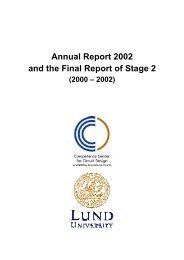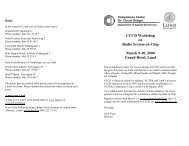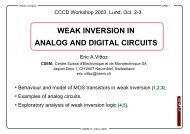Design of Antennas for Handheld DVB-H ... - Lunds tekniska högskola
Design of Antennas for Handheld DVB-H ... - Lunds tekniska högskola
Design of Antennas for Handheld DVB-H ... - Lunds tekniska högskola
You also want an ePaper? Increase the reach of your titles
YUMPU automatically turns print PDFs into web optimized ePapers that Google loves.
and about 1.3 meters when measuring on 700 MHz. This distance in the chamber<br />
used is only about one meter. This will also increase the uncertainty <strong>of</strong> the<br />
measurements.<br />
The probes are designed to send frequencies down to 700 MHz and do not work<br />
very well <strong>for</strong> lower frequencies. Since the measurements are done relatively this<br />
should not affect the results.<br />
All these possible error contributions give a pretty big uncertainty <strong>for</strong> the absolute<br />
value in the measurements. However the different prototypes that have been<br />
measured could be compared to each other with a rather high precision.<br />
5.2 Testing with <strong>DVB</strong>-T receiver<br />
Since <strong>DVB</strong>-H is supposed to be sent with the same base stations as <strong>DVB</strong>-T and<br />
on the same channels one can draw the conclusion that <strong>DVB</strong>-H will be sent with<br />
the same power as <strong>DVB</strong>-T. If <strong>DVB</strong>-H becomes successful the plan is to build<br />
more transmitters to get better coverage. The present <strong>DVB</strong>-T base stations<br />
transmit with 50 000 Watt ERP.<br />
From the antenna point <strong>of</strong> view it is the same thing to receive a <strong>DVB</strong>-H signal as<br />
a <strong>DVB</strong>-T signal. A difference between the two signals is that the <strong>DVB</strong>-H signal is<br />
harder coded with MPE-FEC than the <strong>DVB</strong>-T signal. A <strong>DVB</strong>-H receiver will<br />
there<strong>for</strong>e need lower received signal strength to have good reception. In other<br />
words, if our antennas can receive and show a <strong>DVB</strong>-T signal they will also be<br />
able to receive and show <strong>DVB</strong>-H signals.<br />
A relevant test <strong>for</strong> the built antennas is there<strong>for</strong>e to try and receive digital TV with<br />
them in different environments. This was done with a laptop and a <strong>DVB</strong>-T box<br />
that was connected to the computer through a USB 2.0 port. The <strong>DVB</strong>-T box<br />
antenna connection is matched to 75Ω and all the antennas built are matched to<br />
50Ω. The tested antennas will need somewhat higher signal strength together with<br />
the <strong>DVB</strong>-T box than they will with a future <strong>DVB</strong>-H receiver since this will be<br />
matched to 50Ω.<br />
At the moment there are five different channels transmitted in Skåne at 482, 506,<br />
634, 794 and 818 MHz. The tests were done on 482 and 506 MHz because these<br />
are the only channels that transmit programs free <strong>of</strong> charges.<br />
To get an idea <strong>of</strong> how strong the <strong>DVB</strong>-T signal is the constructed dipole antenna<br />
was connected to a spectrum analyzer and the signal strength <strong>of</strong> the different<br />
channels were measured. Inside Perlos laboratory no signal could be found. To get<br />
a signal the window had to be opened, and then signal strength <strong>of</strong> around –80dBm<br />
70














